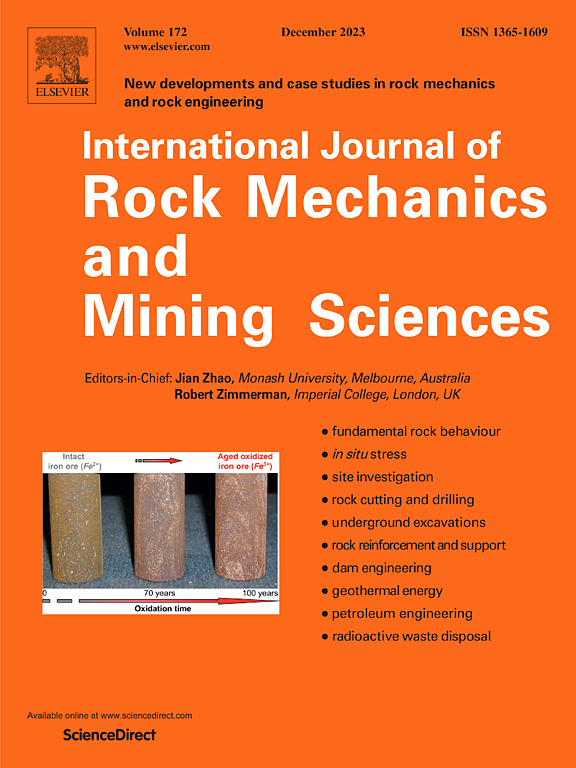矿物组成和孔隙结构对页岩微观拉伸力学性能的影响:来自分子动力学模拟的见解
IF 7
1区 工程技术
Q1 ENGINEERING, GEOLOGICAL
International Journal of Rock Mechanics and Mining Sciences
Pub Date : 2025-04-23
DOI:10.1016/j.ijrmms.2025.106123
引用次数: 0
摘要
页岩油气是重要的非常规油气资源,勘探潜力巨大。页岩的拉伸力学性能对提高油气采收率至关重要。通过分子动力学模拟来研究页岩的拉伸特性。研究了页岩矿物组成和孔隙结构对其拉伸力学性能及微观机制的影响。结果表明,与单一矿物模型相比,复合材料模型的抗拉强度普遍降低(降低47.1% - 98.8%)。在001方向上,干酪根-蒙脱土模型的抗拉强度比蒙脱土高10.1%。与干酪根相比,该复合模型的抗拉强度提高了157.3% ~ 1859.6%。然而,干酪根-方解石模型在001方向上的抗拉强度比干酪根低31%。孔径从2 nm增加到10 nm,导致所有矿物的杨氏模量在所有晶体方向上降低1.5% - 99.3%。高岭石在100晶方向上杨氏模量降低幅度最小(1.5%),在001晶方向上杨氏模量降低幅度最大(99.3%)。揭示了孔隙形态对损伤抗力的几何控制机制,不同孔隙形态对损伤抗力的影响存在差异,表现出与取向相关的破坏模式,裂隙型孔隙在100和010晶体方向上具有最大的稳定性,而三角形结构在001晶体方向上占主导地位。这些发现在原子尺度上建立了结构-性质关系,促进了对页岩破坏机制的基本理解,同时为预测水力裂缝扩展和优化储层增产策略提供了相关的工程指导。本文章由计算机程序翻译,如有差异,请以英文原文为准。
Influence of the mineral composition and pore structure on the tensile mechanical properties of shale from a microscopic perspective: Insights from molecular dynamics simulations
Shale oil and gas—important unconventional hydrocarbon resources—exhibit huge exploration potential. The tensile mechanical properties of shale are crucial for enhancing oil and gas recovery. Herein, molecular dynamics simulations were performed to investigate shale tensile properties. The influence of the mineral composition and pore structure of shale on its tensile mechanical properties and underlying microscopic mechanisms were studied. Results revealed that compared to single-mineral models, composite models generally exhibited considerably lowered tensile strengths (reductions of 47.1 %–98.8 %). However, in the 001 direction, the kerogen–montmorillonite model showed 10.1 % higher tensile strength than montmorillonite. This composite model also showed higher tensile strength than kerogen, exhibiting increases of 157.3 %–1859.6 % in all crystal directions. However, the kerogen–calcite model exhibited 31 % lower tensile strength in the 001 direction than kerogen. An increase in the pore size from 2 to 10 nm resulted in Young's modulus reductions for all minerals by 1.5 %–99.3 % in all crystal directions. Kaolinite exhibited the smallest reduction in Young's modulus in the 100 Crystal directions (1.5 %) and the largest in the 001 Crystal direction (99.3 %). The geometrical control mechanism of pore morphology on damage resistance is decoded, the resistance of different pore shapes to damage varies, demonstrating orientation-dependent failure patterns where slit-shaped pores provide maximum stability in 100 and 010 Crystal directions while triangular configurations dominate in 001 Crystal direction. These findings establish structure-property relationships at the atomic scale that advance fundamental understanding of shale's failure mechanics, while providing engineering-relevant guidelines for predicting hydraulic fracture propagation and optimizing reservoir stimulation strategies.
求助全文
通过发布文献求助,成功后即可免费获取论文全文。
去求助
来源期刊
CiteScore
14.00
自引率
5.60%
发文量
196
审稿时长
18 weeks
期刊介绍:
The International Journal of Rock Mechanics and Mining Sciences focuses on original research, new developments, site measurements, and case studies within the fields of rock mechanics and rock engineering. Serving as an international platform, it showcases high-quality papers addressing rock mechanics and the application of its principles and techniques in mining and civil engineering projects situated on or within rock masses. These projects encompass a wide range, including slopes, open-pit mines, quarries, shafts, tunnels, caverns, underground mines, metro systems, dams, hydro-electric stations, geothermal energy, petroleum engineering, and radioactive waste disposal. The journal welcomes submissions on various topics, with particular interest in theoretical advancements, analytical and numerical methods, rock testing, site investigation, and case studies.

 求助内容:
求助内容: 应助结果提醒方式:
应助结果提醒方式:


